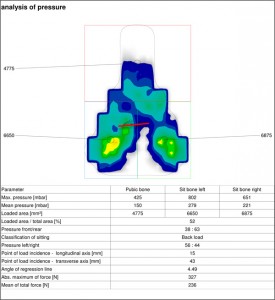Saddle Pressure Scanning Impressions
By Jim Weaver, Service Manager, Fit Werx, VT
Since early 2013, Fit Werx has integrated use of gebioMized Pressure Scanners into the Fit Werx fit protocol. As you have seen from previous posts, both of our Fit Werx bike shop locations (near Burlington, VT and Boston, MA) have two of only a handful of gebioMized Scanners presently in the United States. This scanner opens new doors into tailoring a rider’s position more accurately and has been added to our quiver of tools that help our trained fit technicians optimize the position of our fit clients. Even though I work primarily in the mechanical shop area of Fit Werx, building and servicing bikes, I have had the chance to use the system a little and watch this system in action, and I wanted to post some quick observations.
 While a saddle pressure scanner cannot solve all problems, it can help provide information about how a rider interacts with a given saddle that can help us make more informed recommendations. The scanner is a combination of over 60 pressure sensors built into a cover that fits over most any saddle and proprietary software. The combination shows the distribution of pressure throughout the saddle. The display can be set to a dynamic mode, showing the pressure changes while you are pedaling while another view shows a composite of all the pressure sensed over a given period of time. This can be shown in a 3D, topographical view or a variety of 2D analysis views which include a host of analysis metrics, including the orientation of the hips during pedaling.
While a saddle pressure scanner cannot solve all problems, it can help provide information about how a rider interacts with a given saddle that can help us make more informed recommendations. The scanner is a combination of over 60 pressure sensors built into a cover that fits over most any saddle and proprietary software. The combination shows the distribution of pressure throughout the saddle. The display can be set to a dynamic mode, showing the pressure changes while you are pedaling while another view shows a composite of all the pressure sensed over a given period of time. This can be shown in a 3D, topographical view or a variety of 2D analysis views which include a host of analysis metrics, including the orientation of the hips during pedaling.
What was not so obvious to me initially is how the scanner can show how very small changes in position can sometimes make very noticeable differences in the pressure distribution and pressure peaks on the saddle, as well as the orientation of the hips. For example, the first time we ran the scanner, the rider was not having any specific problems with his current saddle of choice. However, the scan showed definite pressure spikes on the sides of the saddle. This pressure, particularly on the right side, was reduced by simply switching from his current saddle of choice, a Specialized Romin 143, to a wider version of the same saddle, a Romin 155, that supported his sit bones more evenly. However, there was still a localized pressure distribution issue shown by the scanner, primarily on the left side. Ian placed a thin valgus wedge between Bruce’s left Specialized shoe and cleat and adjusted his cleat to encourage his left heel to come in more than it was inclined to do on its own and the difference shown by the scanner was very noticeable. This small change helped smooth out the rider’s overall pressure distribution on the saddle while also improving his hip orientation to a more balanced pattern. The simple expedient of angling the foot that little bit made what to me seemed to be a dramatic change in the distribution of pressure throughout the saddle. Foot wedges have been useful in addressing a variety of foot issues for years, but I never would have thought it could have any significant effect on saddle comfort and the gebioMized saddle scanner provided tangible evidence that these small set-up changes were making a difference in terms of the rider’s alignment and long-term comfort. You learn something new every day, I guess.
Obviously different saddles will vary the pressure distribution. However, for me, the lesson is that even small, seemingly insignificant changes to a rider’s position or equipment can make big differences in long-term alignment and comfort in the saddle. For those with saddle issues, such as pain or numbness, getting a scan with the gebioMized Pressure Scanner with a qualified fitter seems to me to be a no-brainer. Even if you do not feel you have any saddle discomfort, having a scan performed may show that a different saddle may make you even more comfortable than you were. That was the experience of the rider described above. However, to me, the best application of this technology is part of an overall bike fit, where it can be used in conjunction with other tools to help tailor a rider’s position. Saddle problems are not only caused by the saddle, but can be the result of an overall poor position on the bike set-up or, most commonly, deficiencies in the rider’s technique and posture. The gebioMized Pressure Scanner helps the fitter not only see this, but also communicate with the rider better about possible solutions.
Fit Werx’s standard bike fittings include a preliminary saddle scan and Fit Werx also offers saddle pressure scanning as a separate service to help those who benefit from more finite work. If you have any questions about this exciting technology and how it can be used to help enhance your riding, just contact us.
